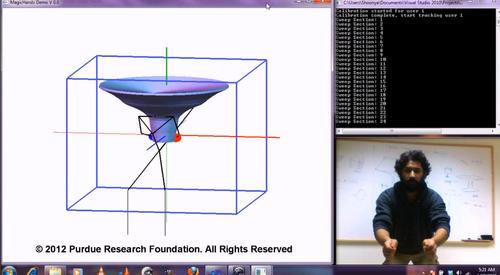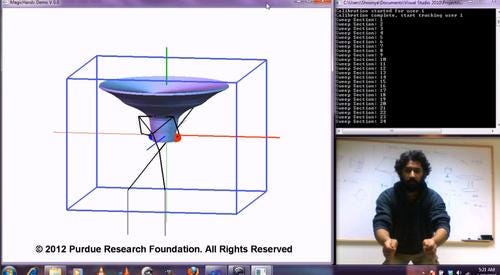Video: Tool Is a Handy Replacement for a Mouse
August 24, 2012

Building 3D models is hard, and using a traditional point-and-click mouse doesn't really do anything to enhance or simplify the process. To solve that dilemma, we're starting to see new R&D efforts that push the boundaries of model development using novel paradigms like movement and gestures.
A research project that's come out of Purdue University is the latest to showcase this kind of technology. A new design tool called "Handy-Potter" takes a page from popular consumer devices like Nintendo Wii or Microsoft's Kinect to let people -- and not necessarily engineers versed in 3D CAD -- create and modify 3D objects with their bare hands. Sounds weird, but if you watch the video below, you can quickly grasp the intuitive side to what its developers say is "rapid 3D shape exploration through natural hand motions."

The system uses a depth-sensing Microsoft Kinect camera to sense 3D space and advanced software algorithms to interpret the hand movements and gestures. Currently being touted as a tool for interior designers and, potentially, engineers, users simply wave their hands in the proper motion outlining a shape, and the computer fills in the rest instantly and, its makers claim, accurately to boot.
"Though current design tools provide complex modeling functionality, they remain nonintuitive and require significant training since they segregate 3D shapes into hierarchical 2D inputs, thus binding the user to stringent procedural steps and making modifications cumbersome," said the project leads in an abstract paper submitted to the ASME 2012 International Design Engineering Technical Conferences & Computers and Information in Engineering Conference, where the Handy-Potter won an "all conference best paper." The paper was written and the project orchestrated by Karthik Ramani, Purdue University's Donald W. Feddersen Professor of Mechanical Engineering, along with graduate students Vinayak, Sundar Murugappan, and Cecil Piya.
In explaining their approach, the team writes:
We present the paradigm of natural and exploratory shape modeling by introducing novel 3D interactions for creating, modifying and manipulating 3D shapes using arms and hands... We integrate the capability of humans to express 3D shapes via hand-arm motions with traditional sweep surface representation to demonstrate rapid exploration of a rich variety of fairly complex 3D shapes. We track the skeleton of users using the depth data provided by low cost depth sensing camera (KinectTM). Our modeling tool is configurable to provide a variety of implicit constraints for shape symmetry and resolution based on the position, orientation and speed of the arms.
We recently told you about another pioneering input device looking to replace the mouse. Leap Motion's Leap offering, which company officials also liken to Microsoft Kinect, attaches to a computer via a USB port and turns it into a gesture-recognition device. Leap is being touted as a more intuitive way to perform basic computer operations, as well as for doing precise 2D and 3D modeling.
To read the Purdue research team's full paper, click here.
Related posts:
About the Author(s)
You May Also Like



